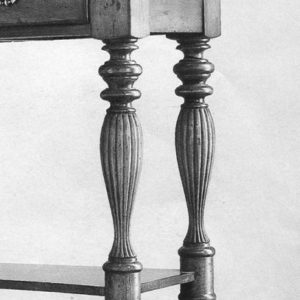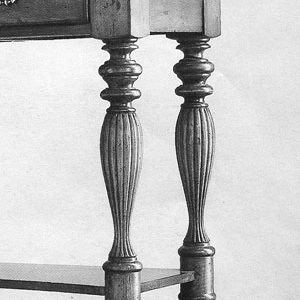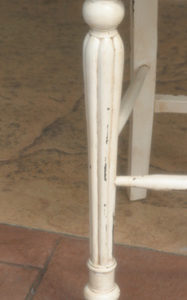I want to make some legs like the ones pictured. I can do the turning part, I’m wondering what the best way to go about the fluting is. One suggestion is to use something like a Vega duplicator. I’m buying the Jet 14″ lathe which has a spindle lock. I didn’t want to spend much more than that as I won’t be doing but a couple dozen of these legs per year. I know it’s not the best lathe in the world, I used to have the Powermatic, but this will do. I’m wondering about some type of jig that would let a trim router ride along the length of the leg while it was locked in the lathe.
Thanks, Bill Lindau
PS Fluted leg3 is the same picture, just a smaller file size of fluted leg2. If the pics are too big for your monitor, right click on the pic icon and choose open in new window.

















Replies
"I'm wondering about some type of jig that would let a trim router ride along the length of the leg while it was locked in the lathe."
Bill
Does this mean you are not interested in doing them by hand? What a wonderful project that would be!
Those are very nice legs and I have not seen any quite like them. I'll be keeping them in mind for possible incorporation of some version in a future project.
Can you tell me about the table?
Thanks
Bob
Bob, the table design is from a picture in a magazine that a customer brought me. I haven't had a lathe for ten years but liked this table ( she wants two of them). The money from this commission will pay for the lathe. Actually, I talked her out of the reeded element for her tables. The trade off is I'm building them out of walnut instead of stained maple like in the magazine. The tables are fairly unnoteworthy except for the legs. I want to learn how to do the reeding for future spec pieces. Bill
Bill,
First a bit of semantics: the legs you posted are reeded, not fluted. Reeding seeks to give the effect of a bundle of soda straws, canes or ...reeds, tied together. Fluting is sort of the opposite , that is, a single column with a series of hollow grooves (flutes) running its length.
If you want to avoid some hand work, you can make a support to mount on the lathe bed, for a router or die grinder that will put the center of the cutter in line with the center of your leg, held in the lathe. You also need an indexing head for the lathe. The bit you want is a vee shaped cutter, actually a quarter-round or roundover bit that comes to a point in the center. Then you will want to make a template for the router to follow, that matches the profile of the reeded section of the leg, so the cutter won't cut too deep. If the profile is at all concave, the router base will need a sub-base with a slight projection to it, so it can follow the concavity.
Alternatively, you can make a "sled" with indexing head to carry the work, held at its centers, past a similarly shaped shaper cutter, with a collar to follow the shaped edge of the sled.
I've used both methods, with limited success. Either way, for attractive results, the reeding needs to be cleaned up by hand. Frankly, for a dozen or fewer legs, I would just lay out and carve the things, held in the lathe, with a parting tool, a skew, and a couple gouges. It'll be faster than making and refining the jigs and templates.
Keep in mind that as the diameter of the turning varies, so will the width of the individual reeds, and their diameter as well, so the size of your cutter can only be an approximation of the largest section of reeding, requiring you to blend the tapering curves by hand for best results. You may have observed machine reeded posts whose reeds have either flat tops at their widest, or sharp edges at the tops of their narrowest dimensions, or both. These turnings often have the reeding terminate at a hollow or coved section of turning, allowing for the cutter to travel past the reeded section unobstructed, also eliminating the need to finish the termination by hand carving the profile into a fillet or corner (as was most often done on period work). To my eye, at least, they look unsatisfactory, another example of an operation that cannot successfully duplicate the effect of hand work.
Good luck with your project,
Ray Pine
Ray, thanks for your detailed reply. By indexing head, do you mean a spindle that locks in equal increments around the revolution? The 14" Jet that I'm buying has 12 positions. My inclination is to build the jig rather than carve the reeds.
"If the profile is at all concave, the router base will need a sub-base with a slight projection to it, so it can follow the concavity" I don't totally comprehend this, it will probably become clearer as I build the jig. The leg in the picture (not the one painted white), is the one I'm going to copy and it does have this belly or concavity. By slight projection, do you mean curvature?
Bill Lindau
Bill,
Yes, the locking device that allows you to divide the spindle into equal spaces is the indexing head.
A flat router base will not allow the cutter to follow or go into a hollow profile, so you need to attach a rounded sub-base (with a "nose") that will allow this. I am thinking of and have used a cutter that presents its end to the work. (I've seen but not used, router bits of a similar profile that are presented sideways- like a shaper cutter-, don't think they will work, as one will need a long shaft to extend the business end of the cutter to the centerline of the turning.) Actually, a tool and diemaker's grinder works best for this, as its base is smaller. Maybe a dremel tool would work, if it has the guts to drive the cutter? Be forewarned that this cut will have a tendency to burn the work, as the bottom-most part of the vee cut leaves little room for dust to escape. Also that the template for the router to follow will need to be slightly different in profile from the turning, to allow for the variance in the cutter's depth of cut, from large to small diameter of the reeds.Is it apparent yet that I'm trying to talk you into doing it by hand? :-)
Ray
Ray, thanks again for your help. I know it must say something about my personality, but I would much rather spend the time refining the jig than carving these out by hand. Bill
Having read your messages in this thread, Bill, it's clear you don't want to carve this feature. However, it's actually a very simple job. A V-tool and shallow gouge like a #4 3/8" is all you'd need and it would go quite quickly. I suspect the time you spend on your jig plus the time spent touching up the router marks will make this evident.
Lee
Lee, I was glad to see that you had weighed in. I really like the looks of these reeded legs but I have an aversion to repetitive work. That's probably why each of my chairs is different from the last. The thought of trying to make 8 legs by hand, that looked the same is daunting to me. At the same time I admire people that can do it without blinking an eye. On the other hand, the engineer in me gets excited about the idea of making a new jig. I've actually waked up in the middle of the night ( last night) and planned out the thing. Anyway, thanks for the vote of confidence.
Bill Lindau
PS Lee, you and I first exchanged messages during the run up to the Irag war. They weren't the friendliest of messages. That was when Jon Arno was still strong and opinionated. What's your take on the war as of late? I know this belongs in the Cafe but I don't go there.
No comment on the war, Lee
Bill, please show us the results of your jig when it's done. I'm curious to see how you deal with the issues us naysayers see.Sorry about the curt reply on the war issue. This is not the place and my opinion is my own.Lee
Bill,
I don't believe any router jig would work, because the "radius" of the reeds change dramatically as they follow the leg contour.
On less bulbous legs, I've used a scratch stock and a trough like fixture bolted to the lathe bed,to rough out reeds, but in this case it will require all hand work. I'm a poor carver, but this a fairly easy, if somewhat time consuming process. Even a router would have left considerable hand work.
Rob Millard
Rob,
I tried to convince Bill, then Lee, now you. Maybe we ought to just let the boy have his fun--he REALLY wants to make that jig!
Momma used to say to me,"If ya won't listen, you'll just have to FEEL!" Just before I experienced the consequences of my actions.
Regards,
Ray
Hello Rob, It sounds like the best I will be able to do is start the process with a jig of some type and then finish up by hand. For someone like myself whose carving skills are nil, that seems the best way to go. And as often happens, what I learn from this jig making may lead to something else even more productive. So do you think the legs I pictured were reeded by hand or does the furniture industry have ways of compensating for the changing radius? Like CNC maybe.
Lee, It will be awhile before I can get to this. But I will post a picture of my jig.
Thanks to everyone who responded. Bill
Bill,
I gave your project some thought, and while I still can't come up with a way to use a router, I did think of one jig that would speed up the process. If I were faced with reeding these legs, I would build a platform that when bolted to the lathe bed was the same height as the centers. Cut the profile of the turning in to this platform ( it wouldn't have to be prefect) Then using a thin scraper held on the platform, draw it down the turning, scratching narrow groove in the turning. This would mark each reed and it would be a simple matter to round over the reeds with a gouge and scraper. The biggest challenge in hand carving reeds is getting them straight and this jig would do that, with relative ease.
I too have wondered how modern furniture is made with details like this. Even though factory furniture is watered down from handmade pieces, I still see details that would be difficult to replicate on machines.
Rob Millard
Thanks Rob, that helps. It will be a good place to get started. It has occurred to me more than once that what I like about woodworking and making things in general, is figuring out how to do something. Then it's the nose to the grindstone. But struggling with a solution and then getting it is a real high. Bill
Like the reply you have from joinerswork, I recommend the hand work. The pictures show a good bit of taper to the reeds as they descend in the concave(slender) section of the leg. For straight legs, the jig method is a good way to go. For bulbous shapes like your photos, you will spend more time making the jigs than you will carving the features. Lonnie Bird's book "Shaping Wood" has some nice ideas in the area you are working. Take a look at a copy it might be helpful. Most importantly, keep the leg in the lathe and make a marking jig that can hold a pencil and slide down the length of the leg to mark the lines on your work piece.
This forum post is now archived. Commenting has been disabled